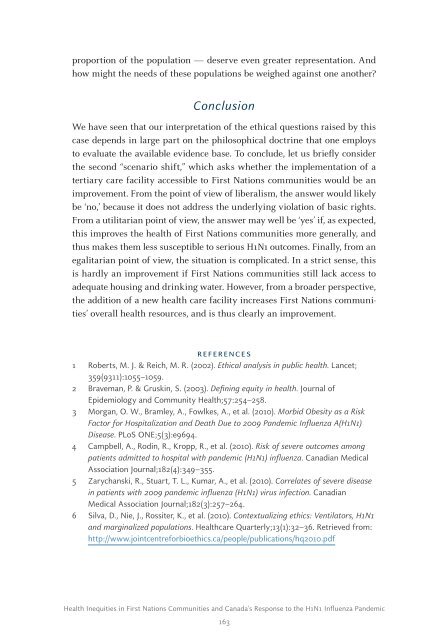PoPulationand Public HealtH etHics
PoPulationand Public HealtH etHics
PoPulationand Public HealtH etHics
You also want an ePaper? Increase the reach of your titles
YUMPU automatically turns print PDFs into web optimized ePapers that Google loves.
proportion of the population — deserve even greater representation. And<br />
how might the needs of these populations be weighed against one another?<br />
Conclusion<br />
We have seen that our interpretation of the ethical questions raised by this<br />
case depends in large part on the philosophical doctrine that one employs<br />
to evaluate the available evidence base. To conclude, let us briefly consider<br />
the second “scenario shift,” which asks whether the implementation of a<br />
tertiary care facility accessible to First Nations communities would be an<br />
improvement. From the point of view of liberalism, the answer would likely<br />
be ‘no,’ because it does not address the underlying violation of basic rights.<br />
From a utilitarian point of view, the answer may well be ‘yes’ if, as expected,<br />
this improves the health of First Nations communities more generally, and<br />
thus makes them less susceptible to serious H1N1 outcomes. Finally, from an<br />
egalitarian point of view, the situation is complicated. In a strict sense, this<br />
is hardly an improvement if First Nations communities still lack access to<br />
adequate housing and drinking water. However, from a broader perspective,<br />
the addition of a new health care facility increases First Nations communities’<br />
overall health resources, and is thus clearly an improvement.<br />
reFerences<br />
1 Roberts, M. J. & Reich, M. R. (2002). Ethical analysis in public health. Lancet;<br />
359(9311):1055–1059.<br />
2 Braveman, P. & Gruskin, S. (2003). Defining equity in health. Journal of<br />
Epidemiology and Community Health;57:254–258.<br />
3 Morgan, O. W., Bramley, A., Fowlkes, A., et al. (2010). Morbid Obesity as a Risk<br />
Factor for Hospitalization and Death Due to 2009 Pandemic Influenza A(H1N1)<br />
Disease. PLoS ONE;5(3):e9694.<br />
4 Campbell, A., Rodin, R., Kropp, R., et al. (2010). Risk of severe outcomes among<br />
patients admitted to hospital with pandemic (H1N1) influenza. Canadian Medical<br />
Association Journal;182(4):349–355.<br />
5 Zarychanski, R., Stuart, T. L., Kumar, A., et al. (2010). Correlates of severe disease<br />
in patients with 2009 pandemic influenza (H1N1) virus infection. Canadian<br />
Medical Association Journal;182(3):257–264.<br />
6 Silva, D., Nie, J., Rossiter, K., et al. (2010). Contextualizing ethics: Ventilators, H1N1<br />
and marginalized populations. Healthcare Quarterly;13(1):32–36. Retrieved from:<br />
http://www.jointcentreforbioethics.ca/people/publications/hq2010.pdf<br />
Health Inequities in First Nations Communities and Canada’s Response to the H1N1 Influenza Pandemic<br />
163
















